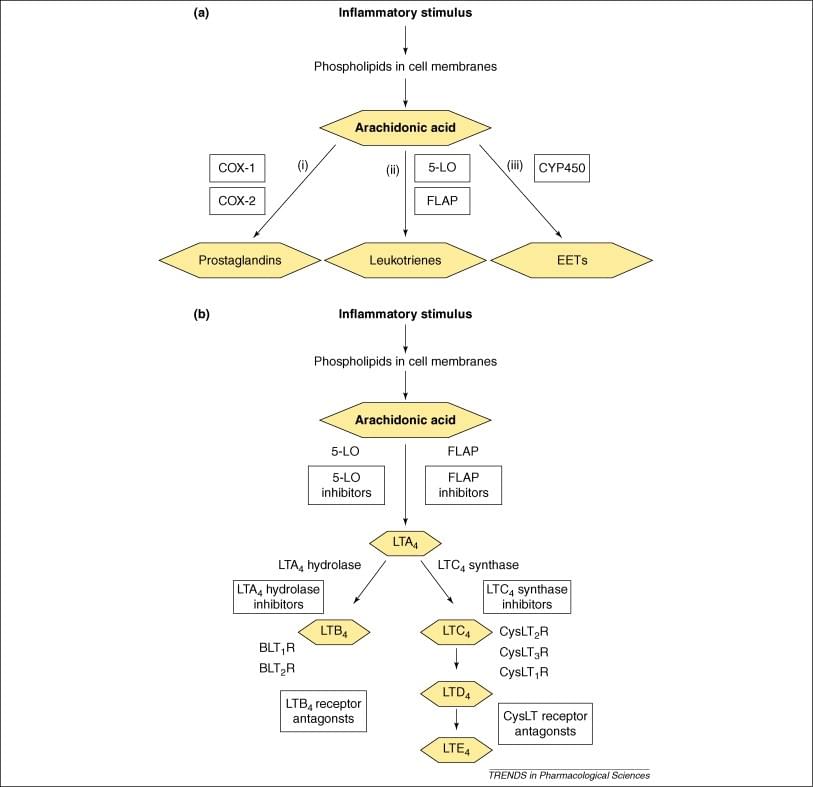Custom MemPro™ Services for MAPEG
Creative Biostructure provides custom gene-to-structure services for MAPEG.
Membrane associated proteins in eicosanoid and glutathione metabolism (MAPEG) is defined according to enzyme activities, sequence motifs and properties. The family contains six main proteins in human including: FLAP (5-lipoxygenase activation protein), LTC4 synthase, MGST (microsomal glutathione) 1-3 and MGST1-like protein. All of the members have a similar amino length of 150 and have a common 12 times transmembrane structure which display complex interaction in inflammatory stimulus.
 Figure 1. MAPEG associated pathway
Figure 1. MAPEG associated pathway
5-Lipoxygenase–Activating Protein, abbreviated as FLAP, is an internal nuclear membrane protein similar to leukotrienes C4 (LTC4) synthase. FLAP does not bind glutathione and has no known enzymatic activity. In addition, FLAP knockdown reduced conversion of leukotriene A4 to leukotriene C4 (LTC4), suggesting a role for the activity of LTC4 synthase. Besides these results, the only known roles of FLAP are to selectively transfer arachidonic acid (AA) to 5-lipoxygenase (5-LO) and enhance the sequential oxygenation of AA to 5(S)-hydroperoxyeicosatetraenoic acid (5-HpETE) and dehydration to leukotriene A4 (LTA4).
Leukotriene C4 synthase (LTC4S), the pivotal enzyme for the biosynthesis of LTC4, is an 18-kDa integral nuclear membrane protein LTC4S catalyzes the key step that conjugates leukotriene A4 with reduced glutathione to form leukotriene C4. The LTC4S monomer has four transmembrane a-helices and forms a threefold symmetric trimer as a unit with functional domains across each interface. Deficient of LTC4S is related with atopic dermatitis that causes abnormal skin thicken. Some LTC4S inhibitors are under development to treat inflammatory diseases.
Prostaglandin E synthases (PGESs), also known as terminal synthases, catalyze the biosynthesis of active PGE2 from cyclooxygenases (COX-1- and COX-2) derived PGH2. Three types of PGESs have been discovered so far, which are referred to as microsomal PGES-1 (mPGES-1), microsomal PGES-2 (mPGES-2), and cytosolic PGES (cPGES). Since COX-1 regulates Gastrointestinal (GI), renal, and vascular functions, to overcome the side effects of cNSAIDs, the selective inhibition of PGESs have become a potential strategy for anti-inflammatory therapy.
MGST1-3 are involved in the cellular defense against xenobiotics and metabolites produced as a consequence of oxidative stress. They also generate glutathione-dependent peroxidase activity against various lipid hydroperoxides.
References:
Evans J F, Ferguson A D, Mosley R T, et al. What's all the FLAP about?: 5-lipoxygenase-activating protein inhibitors for inflammatory diseases[J]. Trends in pharmacological sciences, 2008, 29(2): 72-78.
Ago H, Okimoto N, Kanaoka Y, et al. A leukotriene C4 synthase inhibitor with the backbone of 5-(5-methylene-4-oxo-4, 5-dihydrothiazol-2-ylamino) isophthalic acid[J]. Journal of biochemistry, 2013, 153(5): 421-429.
Singh Bahia M, Kumar Katare Y, Silakari O, et al. Inhibitors of Microsomal Prostaglandin E2 Synthase‐1 Enzyme as Emerging Anti‐Inflammatory Candidates[J]. Medicinal research reviews, 2014, 34(4): 825-855.